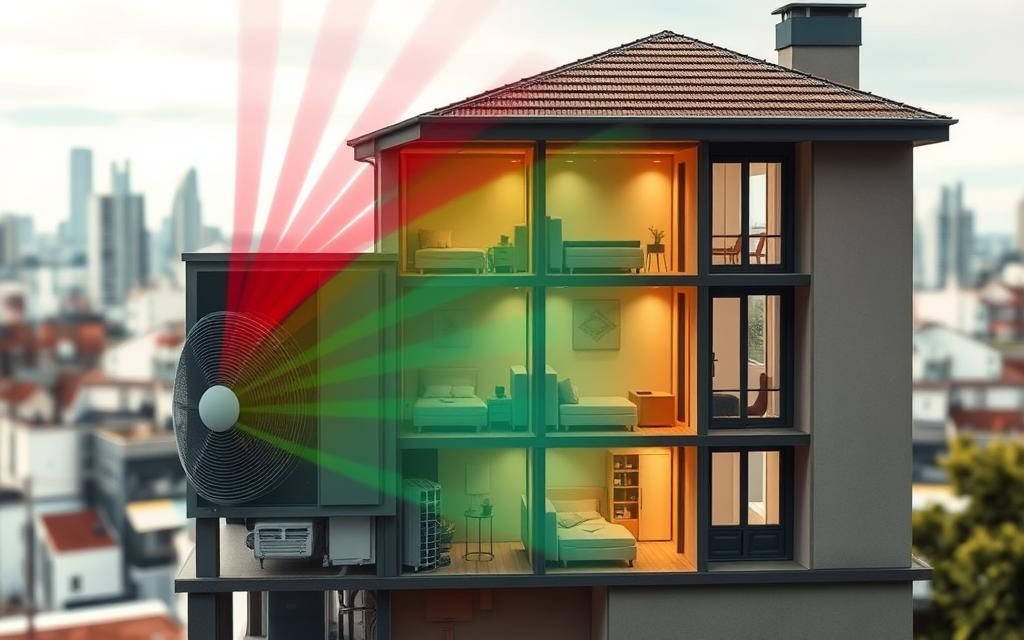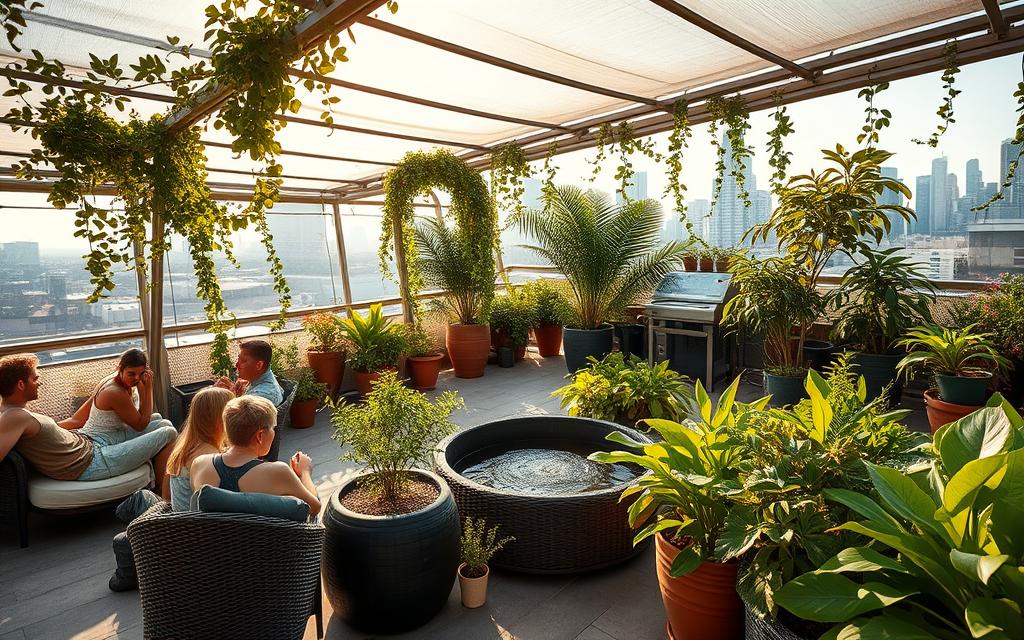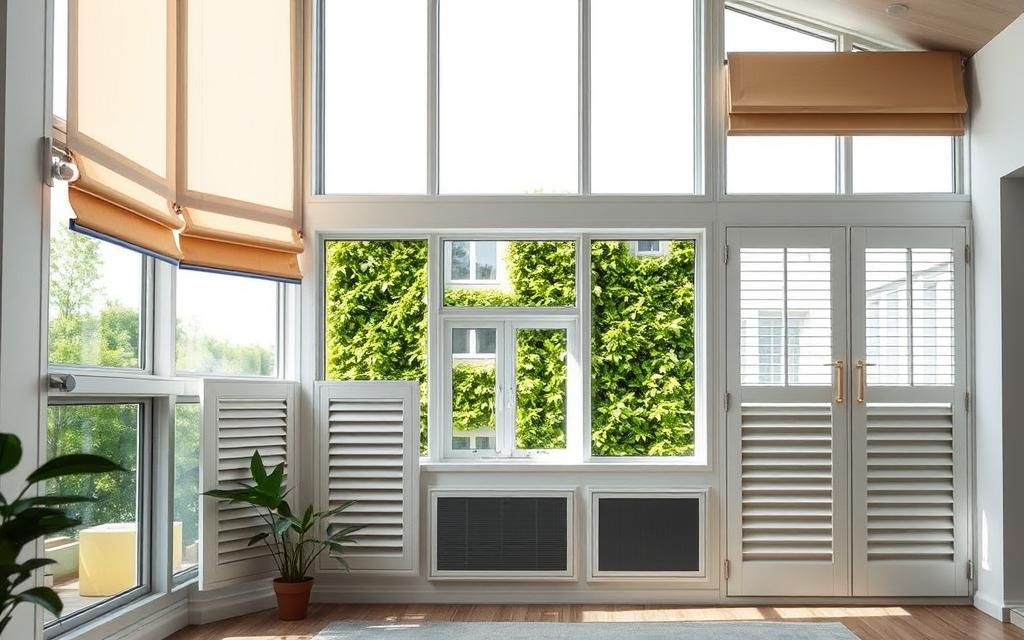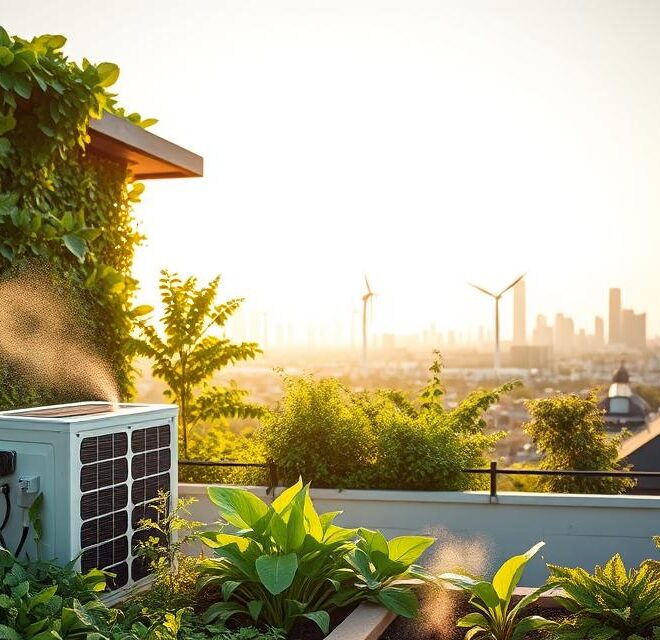As the summer heat intensifies, finding effective eco-friendly cooling solutions becomes a top priority for many homeowners. The quest to beat the summer heat while being kind to the environment can be challenging, but there are several sustainable cooling methods that can help.
From adopting green cooling techniques to investing in energy-efficient cooling systems, there are numerous ways to keep your home cool without harming the planet. In this article, we’ll explore various eco-friendly strategies that not only provide relief from the heat but also contribute to a more sustainable environment.
Understanding the Environmental Impact of Traditional Cooling Methods
While air conditioning provides relief from the heat, its effects on the environment are substantial and multifaceted. The reliance on traditional cooling methods, particularly air conditioning, has become a significant contributor to various environmental issues.
The Carbon Footprint of Air Conditioning
Air conditioning units consume a considerable amount of electricity, which is often generated by burning fossil fuels and thereby releasing greenhouse gases, such as carbon dioxide and methane, into the atmosphere. This contributes to global warming and climate change, creating a vicious cycle where the need for cooling increases as temperatures rise.

Energy Consumption and Rising Utility Bills
The high energy consumption of air conditioners not only harms the environment but also leads to increased utility bills for households and businesses. This financial strain can be significant, especially for low-income households that may already struggle with energy costs.
Health Impacts of Excessive Air Conditioning
Excessive use of air conditioning can have several adverse health effects, including dry skin, respiratory issues, and an increased risk of heatstroke when transitioning between cooled spaces and the outdoors. Maintaining a balanced approach to cooling is essential for mitigating these health impacts.
Understanding these environmental and health impacts is crucial for seeking alternative, more sustainable cooling solutions that not only cool our homes but also mitigate these negative effects.
Cool Down Naturally: Eco-Friendly Ways to Beat the Summer Heat at Home
Embracing eco-friendly cooling solutions can significantly reduce your reliance on mechanical cooling systems. Natural cooling techniques offer a sustainable alternative to traditional air conditioning, leveraging the principles of thermodynamics and airflow to keep your home cool.
The Science Behind Natural Cooling Techniques
Natural cooling is based on simple, effective principles. Shading windows during the day can significantly reduce heat gain, while cross-ventilating your home at night allows cool air to circulate and lower indoor temperatures. Understanding these techniques is the first step towards a cooler, more sustainable home.

Economic Benefits of Sustainable Cooling Approaches
Adopting sustainable cooling approaches not only benefits the environment but also your wallet. By reducing your reliance on air conditioning, you can lower your energy bills. Eco-friendly cooling methods can lead to significant savings over time, making them an attractive option for homeowners.
Creating a Whole-Home Cooling Strategy
Developing a whole-home cooling strategy involves several key steps. This includes day vs. night cooling tactics and seasonal preparation tips. By understanding when and how to cool your home effectively, you can maximize comfort while minimizing energy consumption.
Day vs. Night Cooling Tactics
Cooling your home during the day involves shading windows and using thermal mass to absorb heat. At night, cross-ventilation can cool your home by allowing cooler air to enter. Adjusting your cooling tactics based on the time of day can significantly enhance their effectiveness.
Seasonal Preparation Tips
Preparing your home for the summer heat involves several seasonal tasks. This includes inspecting and upgrading insulation, sealing air leaks, and planting trees or installing shading devices to reduce direct sun exposure. Seasonal preparation is crucial for maintaining a cool, energy-efficient home throughout the summer.
Strategic Home Modifications for Passive Cooling
As the temperature rises, the right home modifications can help maintain a cool and comfortable indoor environment naturally. By implementing a few strategic changes, homeowners can reduce their reliance on air conditioning and stay cool during the summer months.
Upgrading Insulation and Sealing Air Leaks
One of the most effective ways to keep your home cool is by upgrading its insulation. Proper insulation helps to maintain the cool air inside and keeps the hot air out, reducing the need for mechanical cooling. Additionally, sealing air leaks around doors and windows prevents cool air from escaping, further enhancing your home’s energy efficiency.
Window Solutions: Films, Treatments, and Coverings
Windows can be a significant source of heat gain in homes. Applying window films, using thermal treatments, or installing coverings can help reduce this heat gain. These solutions can block direct sunlight, keeping your home cooler and more comfortable.

Creating Effective Cross-Ventilation Pathways
Cross-ventilation is a powerful passive cooling technique that allows hot air to escape and cool air to enter your home. By strategically opening windows and doors, you can create a cooling breeze that reduces the need for air conditioning.
Optimal Window and Door Positioning
The positioning of windows and doors plays a crucial role in cross-ventilation. By opening windows on opposite sides of your home, you can create a pathway for cool air to enter and hot air to escape, enhancing the natural cooling effect.
Using Fans to Enhance Airflow
Fans can significantly enhance airflow and improve cross-ventilation. By using ceiling fans or floor fans in conjunction with open windows, you can circulate air more effectively, making your home feel cooler and more comfortable.
By implementing these strategic home modifications, homeowners can enjoy a cooler, more comfortable living space without relying heavily on air conditioning. These changes not only improve comfort but also contribute to energy efficiency and a more sustainable lifestyle.
Harnessing Nature: Landscaping for Cooler Homes
Landscaping is more than just aesthetics; it’s a powerful tool for natural cooling. By incorporating specific elements into your outdoor space, you can significantly reduce your home’s temperature without relying heavily on air conditioning.
Strategic Tree Planting for Maximum Shade
Planting trees strategically around your home can provide maximum shade, reducing direct sunlight that heats up your house. Deciduous trees are particularly effective as they provide shade in the summer and allow sunlight in the winter.
Vertical Gardens and Living Walls
Vertical gardens and living walls not only add aesthetic value but also help cool the surrounding air through evapotranspiration. This natural process can lower the ambient temperature around your home, making it cooler.
Water Features That Cool Your Surroundings
Water features such as ponds or fountains can cool the air around them through evaporation. The movement of water also adds a soothing element to your outdoor space, enhancing the overall ambiance.
Low-Maintenance Options for Busy Homeowners
For those with busy schedules, there are low-maintenance landscaping options that still provide cooling benefits. Drought-resistant plants and automated watering systems can help maintain your landscape’s cooling effects with minimal upkeep.
By implementing these landscaping strategies, homeowners can create a cooler, more sustainable living environment. It’s about harnessing the natural cooling potential of landscaping to reduce the need for mechanical cooling systems.
Energy-Efficient Appliances and Smart Cooling Technologies
As temperatures rise, energy-efficient appliances and smart cooling technologies can be a game-changer. When mechanical cooling is necessary, choosing the right equipment can make a significant difference in both your energy bills and your environmental footprint.
Selecting and Positioning High-Efficiency Fans
High-efficiency fans are a simple yet effective way to circulate air, making your home feel cooler at a higher thermostat setting. By positioning these fans correctly, you can maximize their impact. For instance, ceiling fans should be set to rotate counterclockwise during summer to push cool air down to the floor.
Eco-Friendly Air Conditioners and Heat Pumps
For times when fans aren’t enough, eco-friendly air conditioners and heat pumps offer more sustainable alternatives to traditional air conditioning systems. These units are designed to provide effective cooling while minimizing energy consumption.
Smart Thermostats and Automated Cooling Systems
Smart thermostats and automated cooling systems can optimize your cooling usage based on your schedule and preferences, reducing unnecessary energy consumption. These systems can learn your habits and adjust the temperature accordingly, ensuring your home is always comfortable while saving energy.
Cost-Benefit Analysis of Upgrading Your Cooling Systems
Conducting a cost-benefit analysis of upgrading your cooling systems can help you make informed decisions that balance upfront costs with long-term savings and environmental benefits. While energy-efficient appliances and smart technologies may have higher initial costs, they often lead to significant savings over time.
DIY Cooling Solutions You Can Implement Today
As the summer heat intensifies, it’s time to explore some effective DIY cooling solutions that can be implemented today. These solutions are not only budget-friendly but also environmentally friendly, helping you stay cool without harming the planet.
Homemade Evaporative Coolers and Ice Fan Techniques
One simple and effective DIY cooling solution is creating a homemade evaporative cooler. By placing a bowl of water in front of a fan, you can cool the air through evaporation, providing a cooler breeze. Another technique is using ice packs or a frozen water bottle in front of a fan to cool the air down quickly.
Cooling Fabrics and Materials for Your Home and Wardrobe
Using cooling fabrics and materials in your home and wardrobe can also help keep you cool. Lightweight, light-colored clothing and bedding can reflect the sun’s rays and keep you cooler. You can also use cooling towels or scarves to stay cool while outdoors.
Natural Cooling Remedies from Around the World
Exploring natural cooling remedies from around the world can offer additional ideas for staying cool. For example, in some cultures, people use wet cloths or special cooling drinks to beat the heat. These remedies can be simple, effective, and easy to implement.
Five-Minute Cooling Hacks for Immediate Relief
For immediate relief from the heat, try these five-minute cooling hacks: take a cool shower, drink a cold glass of water, or apply a cold compress to your pulse points. These simple hacks can provide quick relief on hot summer days.
Taking Action: Your Sustainable Summer Cooling Plan
Now that we’ve explored various eco-friendly cooling solutions, it’s time to put them into action. Creating a sustainable summer cooling plan involves assessing your current cooling practices and identifying areas for improvement. By implementing eco-friendly cooling strategies, such as natural cooling techniques and energy-efficient cooling appliances, you can enjoy a comfortable summer while minimizing your environmental impact.
Start with small changes, like using high-efficiency fans or applying window films, and gradually work your way up to more significant modifications, such as upgrading to green cooling techniques or installing smart thermostats. Every step you take can contribute to a cooler, more sustainable home. By taking action and making conscious choices about how you cool your home, you can reduce your energy consumption and create a more environmentally friendly living space.
With a well-planned sustainable summer cooling plan, you can stay cool while doing your part for the planet. Begin your journey today and discover the benefits of a cooler, greener home.







